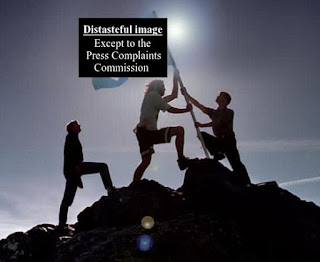Earlier this year, a Sunday newspaper (and we use the term ‘newspaper’
very loosely) created and published an image which twisted the Saltire into a Nazi
symbol. This came alongside the headline
‘Klan Alba’, an attempt, which to the best of our knowledge has not been
denied, to associate Scottish Independence movements to the American fascist group,
the Klu Klux Klan. This act (which would
have been illegal in Hungary, Poland, Germany, Brazil and many other nations) was
met with widespread disgust. With hopes
that this would not happen again, many turned towards the Press Complaints
Commission for assistance. After weeks
of waiting we finally have their view on the issue.
“The image (swastika) had been used to illustrate the article in a provocative manner. Viewed in the context of the coverage as a whole, the Commission took the view that the use of the picture and the headline had not been significantly misleading.”
This came as a surprise to us. If twisting the flag of a nation into a
universally despised symbol of evil without a single piece of evidence to
suggest that this had been done previously is not ‘misleading’, then what are
the conditions required for a media outlet to breach the PCC’s rules of
conduct? Let’s see what the Press
Complaints Commission had to say:
“Complainants had suggested that the article had included misleading information about nationalist attitudes in Scotland. Whilst the Commission acknowledged this concern, it was clear from the article that the author had been presenting his own opinion and commentary on the subject. The author had been entitled to express his views under the terms of Clause 1 (iii) which says that journalists are entitled to express their personal views and comments – however robust or controversial they might be – provided that they are clearly distinguished from fact.”
“A number of complainants had expressed concern that the article had been discriminatory. Clause 12 (Discrimination) states that “the press must avoid prejudicial or pejorative reference to an individual’s race, colour, religion, gender, sexual orientation or to any physical or mental illness or disability.” Complainants said that the coverage had been discriminatory towards Scottish people and, in particular, members of the Scottish Nationalist Party. While the Commission understood these concerns, it made clear that Clause 12 does not cover references or generalised remarks about groups or categories of people. The article had not made discriminatory reference towards an individual. In the absence of reference to a particular individual, the Commission did not establish a breach of Clause 12.”
We can draw three conclusions from the above statements:
- First, you can print any comment you want, even as far as suggesting that those who believe Scotland should be a sovereign nation show more ‘receptiveness’ towards fascism, as long as it is comment and has no basis in fact.
- Second, you can’t make discriminatory references towards a specific individual, but you can against a large group of people based on nothing more than their membership of a legal and legitimate political party or their support for a legitimate political viewpoint.
- Third, you can create and publish any image, regardless of taste and decency, provided that it relates in some way to the article in question.
We at Sign for Scotland would never do or support such acts,
and believe that something is wrong here.
For many people, the image which the newspaper created and
published broke sections 4, 4a and/or 5 of the 1986 Public Order Act (http://www.legislation.gov.uk/ukpga/1986/64)
and thus should have received at least a warning over future content. This viewpoint is strengthened when we
consider the chosen publication date was Yom HaShoah (Holocaust Remembrance Day).
How many Yes supporters have received abuse and accusations
of racism as a result of this image? How
many have been intimidated into keeping silent about their views on
independence for fear of repercussions?
How many more newspapers and media outlets will see this case and
believe that they can now do the same, secure in the knowledge that they will face
no penalties from regulators?
The Press Complaints Commission maintains that “there has
been no breach of the Code in this case” and will do nothing more than pass on
the messages it received to the newspaper in question. We don’t believe that this meets their stated
desire of offering ‘a first class service to the public’
(http://www.pcc.org.uk/about/reports/2001/firstclass.html),
but then, who can we complain to?
Drew
If you like this blog, then please consider visiting our other sites:
Facebook - Sign for Scotland
YouTube - Sign4Scotland
Twitter - Sign4Scotland
Facebook - Sign for Scotland
YouTube - Sign4Scotland
Twitter - Sign4Scotland



No comments:
Post a Comment